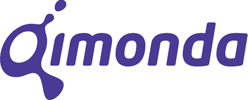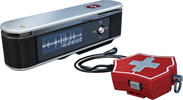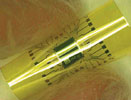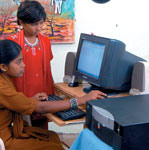
Southern Africa
South Africa is seen as a potential breeding ground for high-quality information communication technology (ICT) professionals, yet our government is still grossly under-skilled. According to ICT research and consulting house, ForgeAhead, this is due to a number of factors, such as a lack of coordination between the education system and labour markets, the fact that demand for IT professionals is outstripping supply and the availability of better opportunities in other countries.
The ICT in Government programme, a research-based initiative by ForgeAhead, is focusing on the use of ICTs at a national, provincial and local government level. "One of the most common findings of our research programme is the general consensus that a lack of ICT skills is undermining service delivery potential," says head researcher Adrian Schofield. "Government has identified this as an issue, but unless there is more collaboration between the public and private sector to develop and transfer skills, the problem will not go away." Government adoption of ICT is speeding up, but Schofield adds that here it faces issues such as legacy systems, lengthy procurement processes and again a lack of skills. In consumer adoption it has grown rapidly when it comes to Internet and telephony, although there are still issues in the more remote parts of the country, he says. ForgeAhead's 5th annual International ICT in Government Summit at Sun City will discuss these and other issues in May.
Glenayre Messaging is expanding its presence in Africa with the official opening of a new office in Ghana. The company, a division of Glenayre Technologies, is a provider of next-generation messaging solutions and enhanced services to wireless and fixed line telecommunications carriers and cable companies.
Fluke distributor Comtest is hosting a 'Power and Thermography' morning workshop. Fluke trainers from Europe will describe typical problems experienced in power reticulation systems. On the thermography side, they will address the setting up of a predictive maintenance programme using non-invasive techniques. The workshops will be held at its offices in Midrand on 11 May as well as in Cape Town on 8 May and in KwaZulu-Natal on 10 May. Contact Sherine Moodley, +27 (0)11 254 2200, or register at www.comtest.co.za.
Overseas
Companies
Lucent Technologies and Alcatel have finalised their proposed 'merger of equals' to create a telecommunications equipment group that will have sales of just over 21 bn Euro. Alcatel will control 60% of the shares and Lucent 40%.
Motorola has agreed to sell its automotive business to German automotive supplier Continental for $1 bn in cash, enabling the communications company to focus more on its wireless and broadband communications businesses. Continental will integrate the acquired business into its Automotive Systems Division. The businesses include Motorola's controls, sensor, interior electronics, and telematics activities.
Sanyo Electric has decided to spin off its unprofitable semiconductor business to increase competitiveness. Sanyo Semiconductor will be created on 3 July with Sanyo holding all shares.
Seeking to expand its portfolio in the emerging fibre-to-the-home (FTTH) arena, PMC-Sierra has entered into a definitive agreement to acquire Passave, a developer of system-on-chip semiconductor solutions for the FTTH access market, for $300m in stock.
UniSource Energy has agreed to sell Global Solar Energy to Solon, a German producer of photovoltaic modules, and a European financial investor.
Infineon has revealed the name of its new memory subsidiary company as Qimonda. The company will debut as the world's fourth largest DRAM manufacturer. Infineon said the brand identity of Qimonda expresses the philosophy and personality of the new company: 'Qi' stands for 'breathing and flowing energy', while 'key-monda' can be interpreted as 'key to the world'. Infineon said it would launch an Initial Public Offering (IPO) of Qimonda as the preferred next step.

Intel Capital, the venture capital arm of Intel, has formed a joint venture with Internet service provider, Pipex Communications of the UK, to create Pipex Wireless, a company chartered with providing Wimax wireless broadband services to enterprises and governments, including citywide wireless access networks. Intel Capital is investing $25m in the company while Pipex has transferred its UK rights to the spectrum at 3,6 GHz, to the joint-venture.
QuickLogic has partnered with Seagate Technology to develop a device for more efficient transfer rates for portable embedded systems that use Seagate's Compact Flash hard disk drives.
Texas Instruments and ARM have announced a collaboration to provide a unified mobile security technology to the industry. The intention is to enable mobile security market applications and services with a standard-based, interoperable, extensible framework. TI will integrate TrustZone software and application programming interfaces from ARM into its M-Shield mobile security technology framework.
OmniVision Technologies, a manufacturer of CMOS image sensors has signed a deal with Germany's Hella KGaA Hueck & Co, one of the world's largest suppliers of automotive parts and accessories, to supply CMOS image sensors for Hella's automotive rearview camera products. The Hella rear view camera system includes an integrated CMOS camera with an aperture angle of more than 120°, enabling the whole area behind a vehicle to be within the field of view.
Global-Tech Appliances of Hong Kong has announced that its wholly-owned subsidiary, Consortium Investment, has entered into an agreement with Singapore-based Anwell Technologies to form a joint venture to produce organic light emitting diode (OLED) systems in China. Named Lite Array Holdings, the JV will leverage the design and manufacturing capabilities of both companies to pursue the OLED market.
Renesas Technology has joined chip-making consortium, the International Sematech Manufacturing Initiative (ISMI). ISMI's core programs include fab productivity, equipment productivity, metrology, environment/safety/health, and next wafer size.
Zentrum Mikroelektronik Dresden (ZMD) has announced it has started working with the US subsidiary of Renesas Technology to offer a wireless sensor for ZigBee networks. The product would combine the ZMD44102 ZigBee transceiver with Renesas' M16C microcontroller and ZigBee software.
Analog IC supplier Linear Technology has signed an agreement with digital IC supplier, Primarion, to produce digital point-of-load (POL) products for networking, computing and telecommunications infrastructure. The two will dual-source Primarion's Di-POL family of PMBus-compliant digital DC-DC controllers. The PMBus standard enables system-level communications with multiple POL converters for programming and monitoring of complex power systems.
Industry
In what is historically a poor month for semiconductor sales, worldwide shipments in February came in at $19,2 bn in February, 6,8% higher than for the same month last year. The Semiconductor Industry Association (SIA) said the figures reflected a 2,2% sequential decline from that reported in January. Notes SIA president George Scalise, 'There is some evidence of inventory accumulation of semiconductors and finished electronic products during the first quarter of 2006. We expect the electronic industry supply chain will respond quickly as it did late in 2004 and that inventories will be in balance by the third quarter.'
Sales of NAND flash memory grew 64% to reach $10,6 bn in 2005, while the market for NOR flash declined 13% to finish the year at $8 bn, according to a report by market analyst IC Insights. Overall, flash memory sales grew 19% to reach $18,6 bn in 2005. Despite the revenue decline, unit shipments of NOR flash increased 9% to reach 4,1 bn in 2005, while shipments of NAND devices increased 88% to reach 1,2 bn.
For the first time in history, the optoelectronics market this year is projected to surpass the discrete semiconductor business and become the second largest segment in the semiconductor industry behind ICs, according to IC Insights. The research group forecasts that sales of optoelectronics devices will increase 11% in 2006 to $16,5 bn, while discretes will grow just 2% to $15,6 bn this year after declining 3% in 2005. Strong demand for image sensors in digital cameras and cellphones, along with new solid-state lighting applications for white LEDs, will push opto sales to $31,8 bn in 2010, it forecasts.
WiMAX services will generate $53 bn in mobile revenue in 2011 and will generate $65 bn in mobile capital expenditures between now and 2011 according to TelecomView's new Broadband report.
Wi-Fi is increasingly being utilised in location-tracking applications, and shipments of Wi-Fi asset tags are expected to reach almost 2 million in 2010, reports In-Stat. Wi-Fi tags are used in Wi-Fi realtime location systems (RTLS) that utilise Wi-Fi access points to locate devices with external Wi-Fi tags or devices with embedded Wi-Fi. Wi-Fi-based RTLS provides the dual advantage of being able to leverage standard Wi-Fi infrastructure for location tracking (instead of having to purchase standalone location reader devices) and, track any devices with embedded Wi-Fi, including laptops, scanners, phones, etc, right along with those assets that have Wi-Fi tags. The Wi-Fi location-tracking market is still nascent, says In-Stat, and many highly changeable factors will decide how fast it grows over the next few years.
RF Micro Devices has announced it would spend $80m expanding its wafer fabrication facility at Greensboro, North Carolina.
A new US public policy 'think tank' focusing exclusively on innovation, productivity, and digital economy issues has been launched. The Information Technology and Innovation Foundation (ITIF) has been created in partnership with the Information Technology Industry Council (ITI). The organisation's mission is to 'advance public policies that boost innovation, e-transformation and productivity' in an effort to boost American competitiveness.
The PC/104 Embedded Consortium has announced that its members have adopted the EPIC specification 2.0, bringing the number of embedded computing standards managed by the consortium to five. EPIC represents the next generation of mid-sized single board computers. The 114 x 165 mm format was originally developed through a combined technical effort from WinSystems, VersaLogic, Octagon Systems, Micro/sys, and Ampro. The EPIC standard aims to provide an optimum combination of small size and adequate space for the latest embedded processors and chipsets and incorporates PC/104-Plus expansion to conveniently add on any PC/104 expansion module.
Europe's largest professional society for engineers, the Institution of Engineering and Technology (IET), was launched on 31 March in London. The new Institution has been formed by the Institution of Electrical Engineers (IEE) and the Institution of Incorporated Engineers (IIE) and has more than 150 000 members worldwide.
Synplicity has announced a refocus of its R&D investment and headcount on its strategic growth opportunities in FPGA implementation and ASIC verification. It said it has decided to withdraw from the cell-based and structured ASIC markets seeing greater returns in its FPGA implementation, ESL synthesis for DSP and ASIC verification products.
Geneva, Switzerland, has been named to host ITU Telecom World 2009. ITU Secretary-General Yoshio Utsumi said that 'the Geneva authorities have made rigorous efforts to underline their support for the event, and have provided the most cost-effective package for the exhibitors, participants and organiser alike.'
The SGS website is a valuable source of information on the RoHS Directive, with comprehensive details of exemptions from the directive. On 1 July 2006 the RoHS Directive (2002/95/EC) becomes enforceable, banning the placing on the EU market of new electrical and electronic equipment (EEE) containing more than 0,1% lead, mercury, hexavalent chromium, PBB or PBDE and puts a limit of 0,01% on cadmium content. The RoHS Directive covers almost all kinds of EEE 'designed for the use with a voltage not exceeding 1000 volts for alternating current and 1500 volts for direct current'. For a list of all exemptions both currently in force and under consideration see www.rohs.sgs.com.
Technology
The Swissmemory s.beat digital audio player from Swissbit and Victorinox, the maker of the world-renowned Swiss Army Knife, is an all-in-one digital audio player and USB storage device incorporated into a full-metal Swiss Army Knife that includes scissors, nail file/screwdriver and blade/knife. Powered by the SigmaTel's STMP3550 chip, the s.beat can store data and music files and offers up to eight hours of playback. It also has a built-in FM radio and remote control.

Omron of Japan has developed electronic control antenna technology claimed to be the first embedded in an UHF-band RFID reader, which can improve RFID tag reading performance. According to Omron its technology can electronically control the direction of the electromagnetic field emitted from the reader, reducing reflections, and so minimise the degradation of system performance due to multipath interference. Multipath interference is an inherent problem for UHF RFID tags, which can make a tag unreadable even if well within range.
European research institute IMEC and its associated laboratory Intec at the University of Ghent, have developed a process to produce ultra-thin flexible packaging for integrated circuits. These bendable packaged chips are only 50 µm in thickness. The technology promises embedding of packaged chips in flexible boards empowering smart, highly-integrated, flexible electronic systems for a variety of applications such as smart textiles and flexible displays. According to the group, the process has been demonstrated with silicon die thinned down to between 20 and 30 μm. The packaging includes polyimide layers and metal, taking overall thickness to 50 µm. The chip package can provide an 'interposer' with a contact fan-out with more relaxed pitches to enable testing of the chip before embedding, IMEC said.

Texas Instruments has started sampling a device that integrates mobile WLAN, Bluetooth and FM stereo audio in one chip. Called WiLink 5.0, this is the fifth generation of TI's mWLAN platform, and is said to offer seamless connectivity between wireless LANs and cellular networks, optimised on TI's OMAP-Vox and WiLink technology.
Intel has officially launched its 'community PC platform' developed exclusively to meet the needs of rural villages and communities in India. With an objective to bridge the urban-rural divide, Intel also announced its 'Jaagruti' (Awakening) initiative designed to provide rural communities in India with greater economic and social opportunities. The community PC was developed to be a fully functional, expandable and shared-access reliable computing solution that supports remote diagnostics and control features under low power requirements (<100 W). It has a ruggedised chassis to withstand dusty conditions, varying temperatures and high humidity, and has a removable dust filter and integrated air fan to correctly regulate the motherboard temperature in ambients as high as 45°C with high humidity levels.

Infinera claims to have successfully completed a lab demonstration of a large-scale photonic integrated circuit (PIC) capable of carrying data at a rate of 1,6 Tbps - the highest datarate yet achieved for a single PIC. The PIC includes more than 240 optical devices on chip. At a 1,6 Tbps datarate, this single chip would be capable of transmitting simultaneously more than 50 million Internet telephone calls, or 160 000 high-definition television broadcasts, claims Infinera. Photonic integration is a key technology for enabling optical networks to scale to carry Internet traffic as Internet bandwidth demand continues to rocket.
Thomson of France has unveiled two front-end digital TV reference designs based on the company's first digital TV chips for the merchant market. The demodulator designs, developed by Thomson Silicon Components, are based on the company's recently introduced Vlink 4110C and VSBlink 4111A DTV front-end ICs for digital televisions and set-top boxes. Each IC includes a vestigial sideband (VSB) demodulator for digital terrestrial transmission and a quadrature amplitude modulation (QAM) demodulator for digital cable.
IBM scientists have developed a powerful new technique for exploring and controlling magnetism at its fundamental atomic level. According to the scientists, they can now position atoms and then measure and control their magnetic interactions within precisely designed structures. The new method, called spin-excitation spectroscopy, is essential for the long-term future of computer circuits and data-storage elements. They believe it will be impossible to simply continue improving transistors and other traditional microelectronic circuit elements by merely shrinking them, saying there is a need for alternative structures and, perhaps, altogether different ways of computing.
Microdisplay supplier eMagin has received an approval of a patent for a portable communication device with a virtual image display. According to eMagin, such a device would deliver large-screen, high-resolution data displayed from a handheld device through a virtual image that only the individual user could see. These devices that would enhance and extend the utility of cellphones, PDAs, personal media players, and portable or wearable computers.


© Technews Publishing (Pty) Ltd | All Rights Reserved